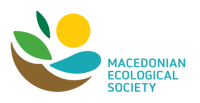Determination of genotoxicity in waters from the region of Tetovo
DOI:
https://doi.org/10.59194/MJEE22242089tKeywords:
Allium test, Tetovo region, heavy metals, chromosomal aberrations, mitotic indexAbstract
This research examines the genotoxicity of water samples collected from 10 locations in the region of Tetovo (Republic of North Macedonia): Dolno Sedlarce, Railway station-Tetovo, Vratnica, Lavce, Raotince, Trebos, Brvenica, Banjice, Volkovija, and Dzhepchishte. The concentrations of several heavy metals (Cr, Cu, Zn, Mn, Fe, Pb, Cd, Co, and Ni) were measured. Allium test was used to examine the genotoxicity of the water samples, with the roots being collected in three series. Mitotic index (MI), index of aberrations (IA), and the presence of various chromosomal and mitotic aberrations were determined as part of the analysis of cytogenetic parameters. The results of the chemical analysis showed that the water samples had partial contamination with heavy metals. The concentration of heavy metals was highest in the sample from the Railway station. The heavy metals with the highest measured concentrations are zinc, copper, manganese, and cadmium. MI in the second and third collection series was lowest in the bulbs placed on water samples from the Railway station. The bulbs placed in water samples from Vratnica, Lavce, Raotince, and Banjice showed an increase in MI. In the first and third series IA was highest for the bulbs placed on the water samples from Railway station. Different chromosomal and mitotic aberrations were detected including chromosomal bridges, C-mitoses, vagrants, laggards, sticky chromosomes, irregular anaphases, binucleated cells, micronuclei, elongated nuclei, fragmented nuclei, nuclear buds, and fragmented nuclei. Most of the structural chromosomal and mitotic aberrations (with frequent chromosomal bridges) were observed in the material placed on water samples from the Railway station. The results obtained from this research indicate a particular genotoxic impact of some of the waters in the region of Tetovo.
Downloads
Published
How to Cite
Issue
Section
License
Copyright (c) 2022 Slobodan Tofiloski, Gordana Dimeska, Lenka Cvetanovska, Slavčo Hristovski, Ivana Dilevska

This work is licensed under a Creative Commons Attribution 4.0 International License.
Macedonian Journal of Ecology and Environment applies the Creative Commons Attribution 4.0 International ![]() license to articles and supplementary material we publish. If you submit your paper for publication to Macedonian Journal of Ecology and Environment, you agree to have the CC BY license applied to your work. Under this Open Access license, you as the author agree that anyone can reuse your article in whole or part for any purpose, for free, even for commercial purposes. Anyone may copy and redistribute the material in any medium or format as long as the author and original source are properly cited. This facilitates freedom in re-use and also ensures that Macedonian Journal of Ecology and Environment content can be mined without barriers for the needs of research.
license to articles and supplementary material we publish. If you submit your paper for publication to Macedonian Journal of Ecology and Environment, you agree to have the CC BY license applied to your work. Under this Open Access license, you as the author agree that anyone can reuse your article in whole or part for any purpose, for free, even for commercial purposes. Anyone may copy and redistribute the material in any medium or format as long as the author and original source are properly cited. This facilitates freedom in re-use and also ensures that Macedonian Journal of Ecology and Environment content can be mined without barriers for the needs of research.
Author - the holder of copyrights is encouraged to sign and return the Copyright form prior to the publication of the scientific article.
Licencing:

Macedonian Journal of Ecology and Environment is licensed under a Creative Commons Attribution 4.0 International License.

